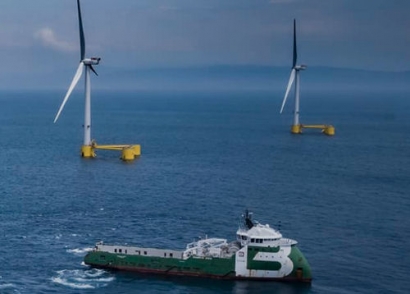
TotalEnergies SBE US will combine TotalEnergies’ expertise in large-scale offshore projects, Simply Blue Group’s floating know-how, and a team of pioneers of the U.S. offshore wind industry, to unlock untapped deep-water opportunities that will provide renewable electricity to millions of U.S. homes.
“Our ambition is to install 100 gigawatts of global renewable power generation by 2030, part of which will come from floating offshore wind projects. We are eager to see this partnership with Simply Blue help our Company meet this goal,” said Stéphane Michel, President, Gas, Renewables & Power at TotalEnergies. “We are convinced of the large potential of floating offshore wind to provide U.S. coasts with renewable electricity, and are committed to contribute our extensive expertise in offshore projects to make it happen.”
“The future and next frontier of U.S. offshore wind is floating. This joint venture with TotalEnergies has everything we need to deliver floating offshore wind on America’s coasts,” said Sam Roch-Perks, CEO, Simply Blue. “Almost two-thirds of U.S. offshore wind resources are found in deeper waters that require floating wind platforms. TotalEnergies SBE US brings together the scale, expertise, and international track record to responsibly develop floating offshore wind power on all of America's coasts.”
“Offshore wind has arrived. To bring its full benefits to market, we need to go big and go deep,” said Stephanie McClellan, Ph.D., Chief of Strategy & Policy, TotalEnergies SBE US and founder, Special Initiative on Offshore Wind. “TotalEnergies SBE US will accelerate development of U.S. floating wind, and help states and the federal government meet their clean power goals."
Today, TotalEnergies has over 6 GW of offshore wind in development around the globe, of which over 40% is comprised of floating offshore wind including over 2 GW of floating wind projects in South Korea. Simply Blue Group has more than 3.2 GW of offshore wind in development off Ireland and the UK.
About the U.S. offshore wind market
In March 2021, the Biden Administration set a 30 GW goal for U.S. offshore wind by 2030. Deep waters off the coasts of California, Oregon, Hawaii, Gulf Coast, and the East Coast hold as much as 35 GW of development potential by 2040. Along with enabling access to deep-water sites, floating wind offers additional advantages: the winds are stronger and more stable away from the coast, which allows for higher yields, and the wind turbines are out of view from the coast. The global pipeline of floating offshore wind projects more than tripled in 2020 alone to exceed 25 GW, according to the U.S. Department of Energy, with floating wind costs decreasing rapidly. For the United States, the National Renewable Energy Laboratory reports some 60% of viable offshore wind resources can only be tapped using floating technologies.

